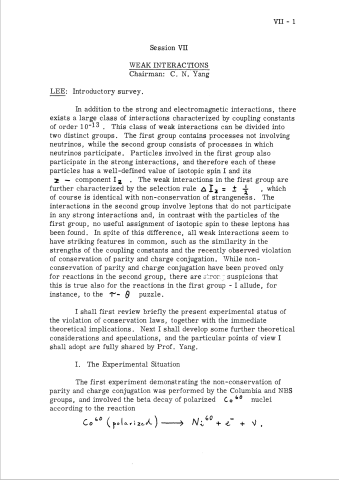Weak Interactions

15-19 April 1957, Rochester, NY, United States (C57-04-15)
-
7th conference in the ICHEP series and
-
7th conference in the Rochester series
T.D. LEE:
We next turn to the Universal Fermi Interaction, which is an attempt to gain a more unified understanding of certain of the weak interactions. We draw the famous triangle representing the interactions of interest:
Beta decay information tells us that the interaction between ( ^p-i v\ ) and ( £ V ) is scalar and tensor, while the two-component neutrino theory plus the law of conservation of leptons implies that the coupling between ( V ) and ( /^y V ) is vector. This means that the Universal Fermi Interaction cannot be realized in the way we have expressed it. If all these coupling types turn out to be experimentally correct, we prefer to think that the similarity in coupling constants cannot be accounted for in terms of such a limited scheme. Rather it is a universal feature of all weak interactions, and not just those involving leptons. Nevertheless, at this moment it is very desirable to recheck even the old beta interactions to see whether the coupling is really scalar, a point to which we shall return later….
,C.S. WU :
First, we may place an upper limit on the contribution from the Z-dependent Coulomb part, using the data supplied by the e-ν angular correlation in the decay of He6. Since Z = 28, α = 1/137 , and the He6 data indicates that the remaining factor is less than 2 /√3, the Z-dependent term is less than 0.23. Therefore most of the asymmetry is provided by the first term. But such a term exists only if neither charge conjugation nor parity are conserved, so the experiment already demonstrates the noninvariance of C and P.
,The evidence on the relative strengths of scalar and vector components in the Fermi interaction is no longer so convincing as we previously had thought, because we don f t know if time reversal invariance holds true. The old methods used beta-neutrino angular correlations to determine the nature of the interactions. For example He6, which decays through a pure G. T. interaction, was used to show that this interaction is mostly tensor. Ne19 was used to investigate the Fermi interaction, but since here a mixture of Fermi and G . T . interactions is involved, this method turned out to be not very sensitive. The decay of A35 would furnish a much more sensitive test, because here I IMgr M p j 1 ^ l/atf Knowledge about the exact nature of the Fermi interaction, i . e . the relative strength of C and C v , becomes essential when we wish to select the best experimental method of testing time reversal invariance.
Nowadays we no longer need to use the beta-neutrino angular correlation method, which is difficult and insensitive. As Prof. Lee has pointed out, the longitudinal polarization of electrons from scalar, pseudo-scalar, and tensor interactions is different from the longitudinal polarization of electrons coming out of vector and axial vector interactions. Therefore it would be most interesting to investigate the longitudinal polarization of electrons coming from pure Fermi decays, i . e . 0 } 0 transitions, of which there are many.